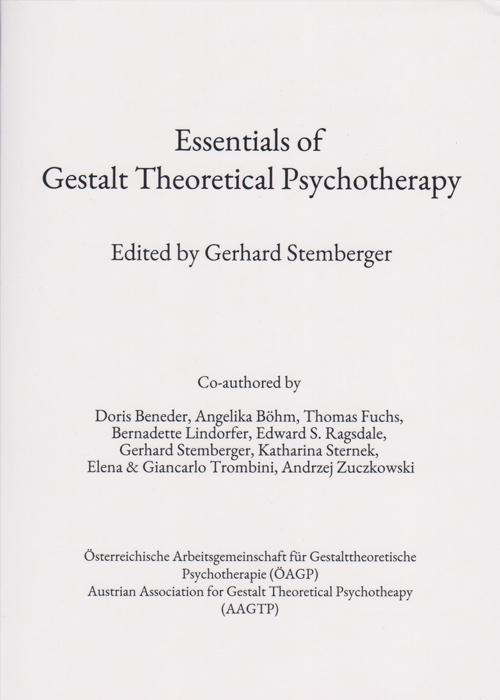Gestalt Theoretical Psychotherapy
A brief Sketch of The History of GTP
Extract from G. Stemberger, The Power and Challenge of Consistency, 2021
The history of the clinical-psychotherapeutic application of Gestalt theory cannot be adequately presented within the narrow confines of this editorial. I must limit myself to some necessarily highly abbreviated remarks.
In the now more than 100-year history of Gestalt theory of the Berlin School (Wertheimer, Köhler, Koffka, Lewin), its approach has radiated from the early beginnings to a multitude of people working in clinical psychotherapy and the “schools of therapy” developed or represented by them. It did so in interaction with similarly directed scientific developments and new orientations of its time, which above all had in common the aim of overcoming mechanistic conceptions of life and man and the search for more appropriate holistic-dynamic alternatives (cf. Ash, 1995; Harrington, 1996, King & Wertheimer, 2005).
read more
For example, people trained and inspired by Gestalt theory significantly influenced the development of group psychoanalysis, psychoanalytic psychotherapy, hypnotherapy, and catathym imaginative psychotherapy, various methods associated with humanistic psychology from Rogers’ client-centered approach to Gestalt therapy and Moreno’s psychodrama, to name a few.
In this broader sense, psychotherapy based on or inspired by Gestalt theory has been around for more than 100 years. However, this early history of Gestalt theory in psychotherapy consisted, on the one hand, of the insertion of certain ideas and concepts, procedures, and research findings from Gestalt theory into other ideas, whereby these adoptions were often not insignificantly distant from their origin; on the other hand, in the personal integration of Gestalt theoretical thought into therapeutic practice by individual clinically active Gestalt psychologists who never set themselves the task of systematically formulating the basic concepts of their Gestalt-theoretical-psychotherapeutic work. (e.g., Erwin Levy, Abraham S. Luchins, Molly Harrower).
The impetus for such a formulation and thus for a Gestalt Theoretical Psychotherapy in the narrower sense was given a little more than 40 years ago by a small group of psychotherapists in Germany around Hans-Jürgen P. Walter and Rainer Kästl within the framework of the GTA (Society for Gestalt Theory and its Applications), which they co-founded in 1979. Walter had previously presented a first outline of a Gestalt theoretical rationale for the integrative application of Gestalt therapy, psychodrama, talk therapy, depth psychology, behavior therapy, and group dynamics in 1977.
Since then, the focus of further development and application of Gestalt Theoretical Psychotherapy has increasingly shifted to Austria, motherland of so many psychotherapy methods in history. It is now being further developed there by the Austrian Association for Gestalt Theoretical Psychotherapy (ÖAGP) with the GTA as its scientific umbrella organization, integrating the impulses of other Gestalt-psychologically oriented clinicians from other countries—among them especially also from Italy (e.g., Giuseppe Galli, Anna Arfelli Galli, Giancarlo Trombini, Andrzej Zuczkowski).
See also (in German) People in the History of Gestalt Theoretical Psychotherapy
Full text articles about GTP in English language – From the special issue of „Gestalt Theory – An International Multidisciplinary Journal“ 43(1), 2021
- Gerhard Stemberger (Vienna and Berlin):
Psychotherapy: The Challenge and Power of Consistency - Katharina Sternek (Vienna):
Critical Realism: The Epistemic Position of Gestalt Theoretical Psychotherapy - Bernadette Lindorfer (Vienna):
Personality Theory in Gestalt Theoretical Psychotherapy: Kurt Lewin’s Field Theory and his Theory of Systems in Tension Revisited - Gerhard Stemberger (Vienna and Berlin):
Ego and Self in Gestalt Theory - Angelika Böhm (Mistelbach and Vienna):
Basic Principles for Therapeutic Relationship and Practice in Gestalt Theoretical Psychotherapy - Thomas Fuchs (Bonn):
Gestalt Theoretical Psychotherapy – A Clinical Example - Giancarlo Trombini, Elena Trombini (Bologna), Gerhard Stemberger (Vienna and Berlin):
Reconciliation of Time Perspectives as a Criterion for Therapy Completion - Edward S. Ragsdale (New York):
Relational Determination in Interpersonal and Intrapsychic Experience
Some additional sources in English language
- Gerhard Stemberger (Vienna and Berlin):
2023 (with Nadia Dario): An Overview of Mind-Wandering According to Boggi’s Approach and Interests. In: Giuseppina Marsico & Luca Tateo (Eds.), Humanity in Psychology. The Intellectual Legacy of Pina Boggi Cavallo. Springer. 67-97. https://link.springer.com/chapter/10.1007/978-3-031-30640-2_8
2024 Reorganizing One’s World: The Gestalt Psychological Multiple-Field Approach to “Mind-Wandering”. In: Nadia Dario & Luca Tateo (eds.), New Perspectives on Mind-Wandering. Springer, 77-101. https://doi.org/10.1007/978-3-031-06955-0_5
- Gerhard Stemberger (Vienna and Berlin):
Some Remarks on the Field Concept in Gestalt Psychology. [2019] [Extract from the article: Trombini, Giancarlo; Anna Corazza; Gerhard Stemberger (2019): Manifest Dream / Association Comparison: A Criterion to Monitor the Psychotherapeutic Field. Gestalt Theory, 41(1).] - Angelika Böhm (Vienna and Mistelbach):
2024 (with Gerhard Stemberger): The Dialogic Triad in Psychotherapy and Clinical Supervision. International Journal of Supervision in Psychotherapy, 6, 23-38.
2023: Supervision as a Space of Creative Freedom – Conditions for Successful Collaborative Practice. International Journal of Supervision in Psychotherapy, 5, 35-45. - Anna Arfelli Galli (Macerata):
The Primary Intersubjectivity and the Gestalt Theory. [2018] Gestalt Theory, 40(2), 175–188. - Giuseppe Galli (Macerata):
Relations and Structures – Gestalt theory as a theory of phenomenal relations. [2007] Gestalt Theory, 29(3), 206-212. - Katharina Sternek (Vienna):
Attachment Theory and Gestalt Psychology [2007]. Gestalt Theory, 29(4), 310-318. - Gerhard Stemberger (Vienna and Berlin):
Diagnostics in Gestalt Theoretical Psychotherapy [2008]. From: Bartuska et al., Psychotherapeutic Diagnostics – Guidelines for the new standard. New York: Springer, pp. 97-108. - Marianne Soff (2013): Gestalt Theory in the Field of Educational Psychology: An Example. Gestalt Theory, 35(1), 47-58.
